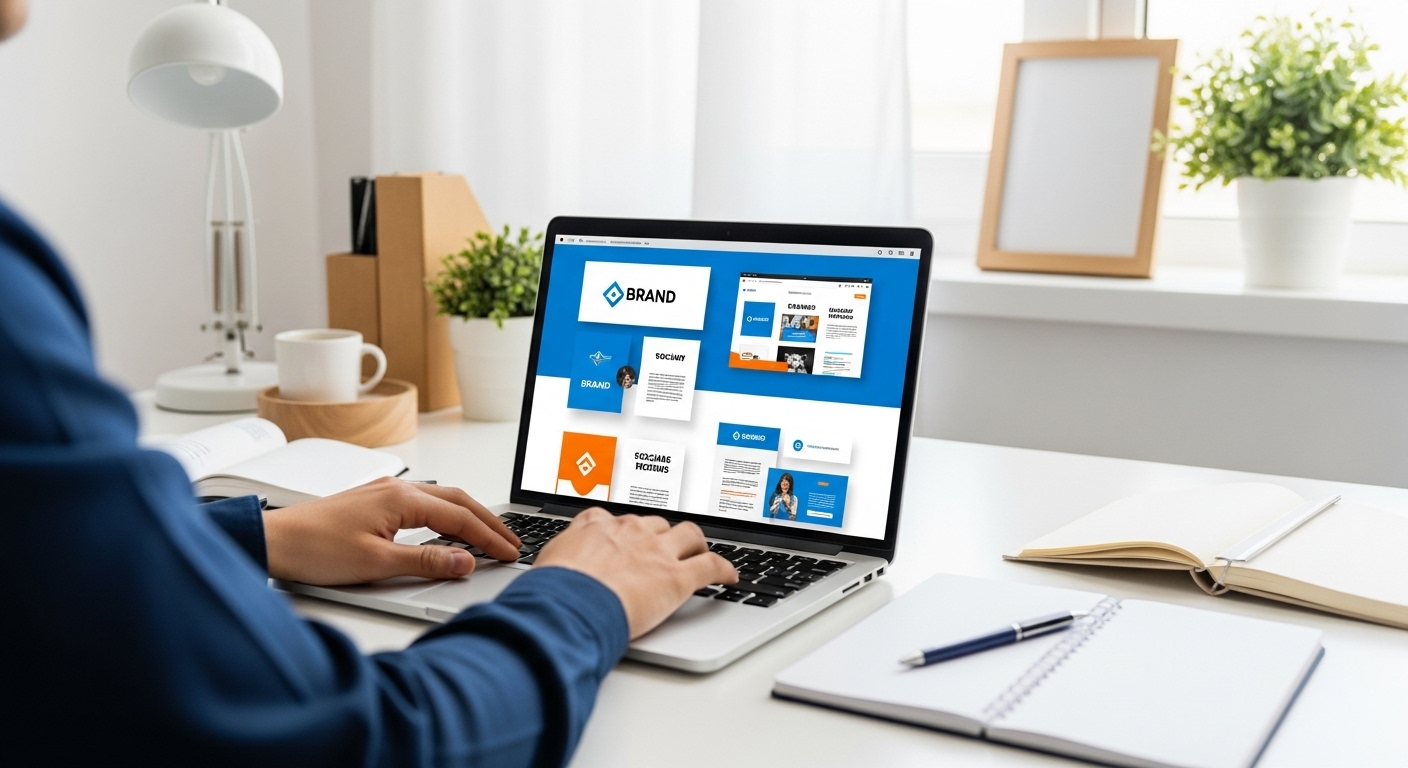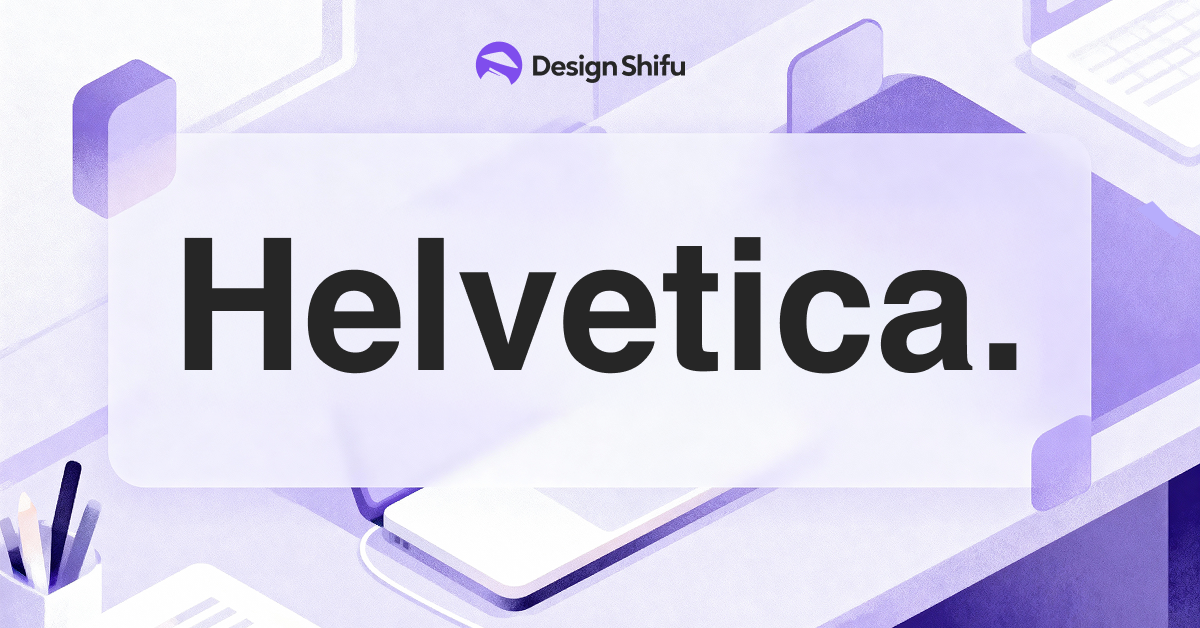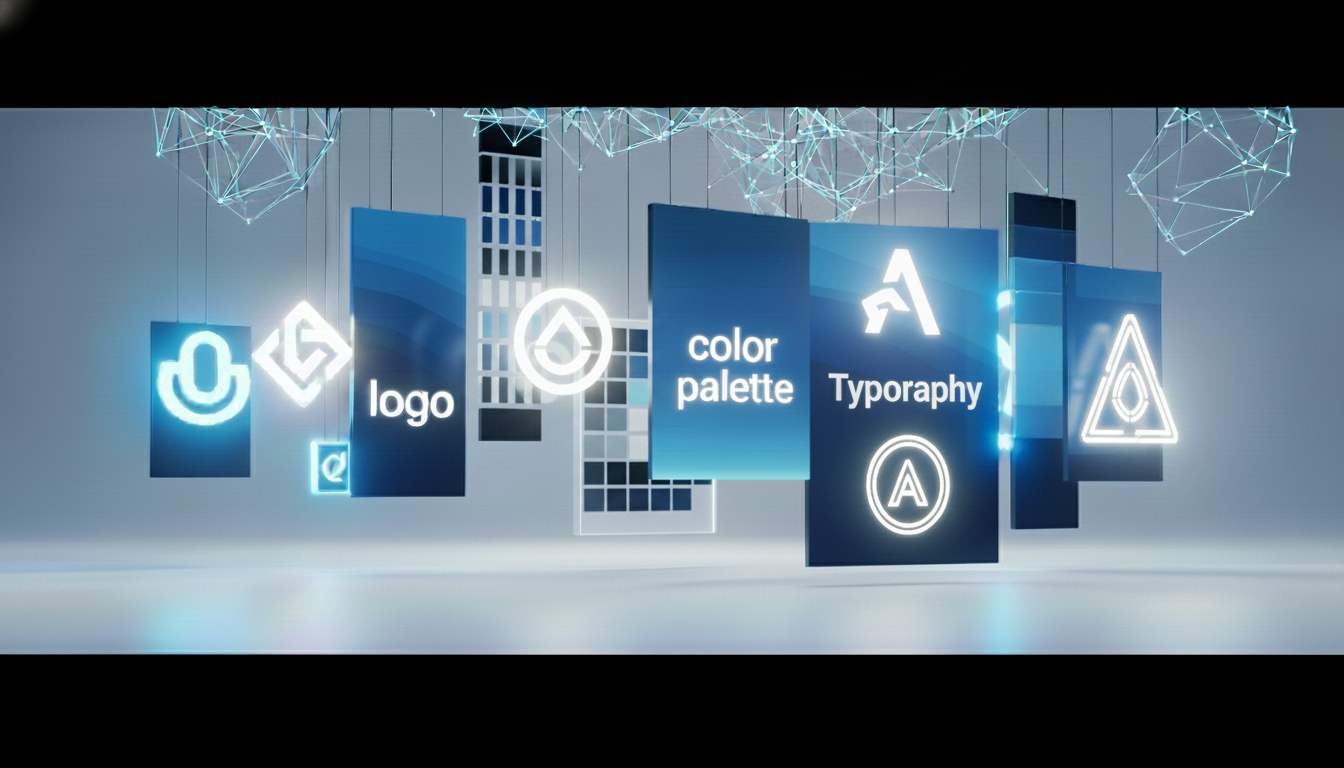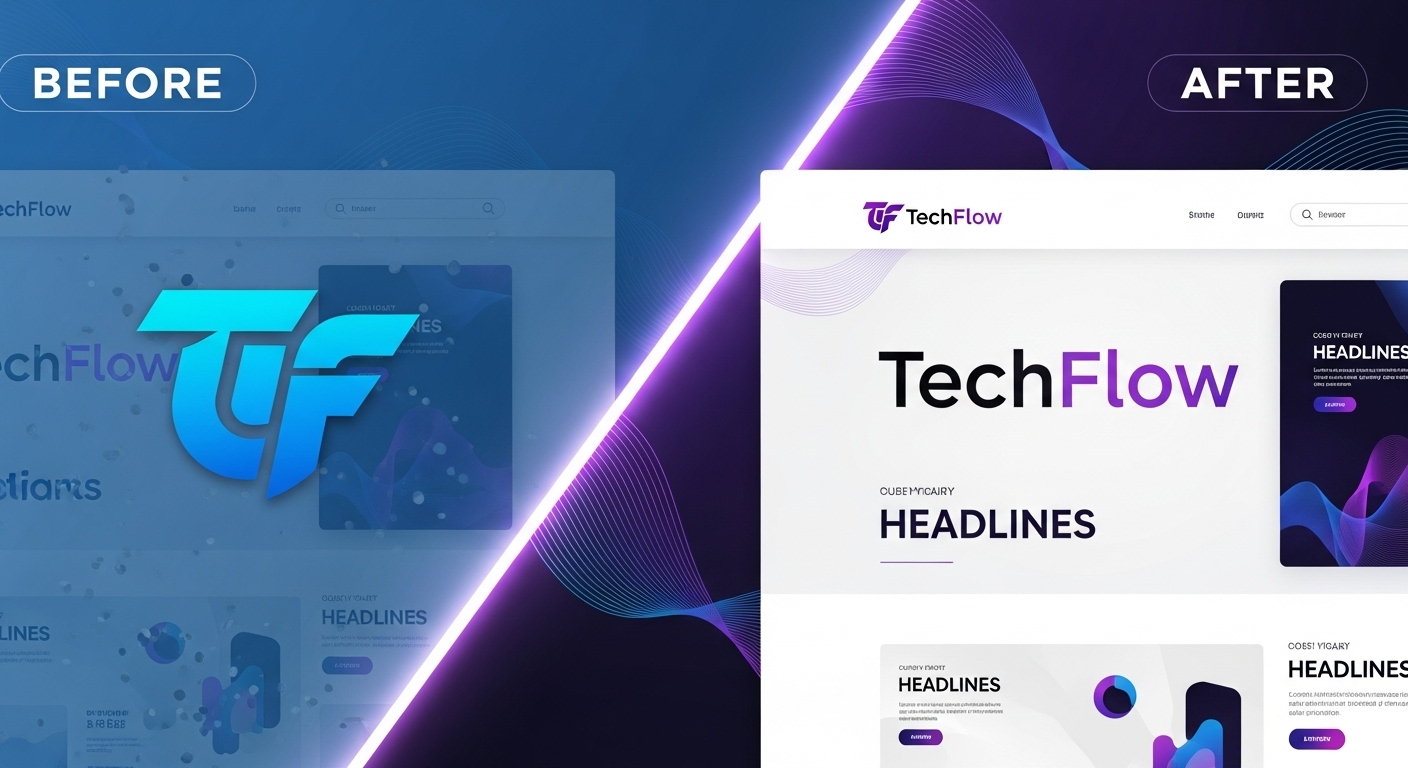Marcus Chen sits in his spare bedroom. One desk. One laptop. One person.
But when you look at his business, you’d swear he has a team of 20 people. His website looks like a Fortune 500 company. His social media feels like a marketing agency runs it and his email newsletters look professionally designed.
Last month, someone offered to buy his company for $800,000. They thought he had employees, office space, and complex operations. He laughed and said no. He’s just one person working from home.
This is the story of how a solopreneur built a brand that looks 10 times bigger than it actually is. For solopreneurs like Marcus, understanding how to create valuable design systems for one-person brands can be the difference between looking small and looking established.
TL;DR
Marcus Chen built a $450,000/year business from his spare bedroom, without employees, office space, or investors. His secret? He made his one-person brand look like a full-fledged company through design systems, professional presentation, and smart branding.
From switching “I” to “we” to investing in professional visuals, creating a systems-driven business, and forming strategic partnerships, Marcus proves solopreneurs don’t need a team to look established — just the right design strategy and mindset.
Who Is Marcus Chen?
Marcus started his business coaching company in January 2022. He helps tech professionals transition into consulting. No employees. No partners. Just him.
When he launched, his brand looked exactly like what it was. A solo operation. His website had his face plastered everywhere, his email signature said “Founder & Everything Else.” His Instagram bio screamed “one-man show.”
Clients hesitated. They wondered if he could handle their needs. Some people asked “Do you have a team?” He’d awkwardly say no, then watch them walk away.
By March 2022, Marcus made a decision. He was going to look bigger than he actually was. Not lying. Just strategic presentation.
Two years later, his business makes $450,000 annually. People regularly assume he has a staff. His brand feels substantial, established, and professional.
Here’s exactly what he did.
Strategy 1: He Stopped Using “I” Everywhere
Marcus’s biggest mistake was making everything about himself personally. His old website said things like:
“I help tech professionals…” “I’ve worked with over 50 clients…” “I believe in transformation…”
This screamed solopreneur. So he changed it to:
“We help tech professionals…” “Our team has worked with over 50 clients…” “We believe in transformation…”
“But that’s lying,” you might think. Not exactly. Marcus considers himself a team of one. “We” can mean one person. Many successful solopreneurs use this language.
The shift was psychological. When potential clients read “we,” they imagined multiple people. They felt more confident. His conversion rate from website visitor to consultation call jumped from 2% to 5%.
The lesson: Change your language from personal to plural. It’s not dishonest. It’s professional framing and part of how brands build a strong brand identity through language and visuals
Strategy 2: He Built a “Team” Page
Marcus created an “About Us” page that looked like a team page. But instead of showing team members, he showed his different roles.
He took five professional photos of himself:
- Marcus in a suit (Strategic Director)
- Marcus in a casual blazer (Lead Coach)
- Marcus in a polo shirt (Client Success Manager)
- Marcus with headphones (Learning & Development)
- Marcus smiling casually (Community Manager)
Each photo had a title and description. He wasn’t pretending to be different people. He was showing all the roles he handles in his business.
Visitors saw diversity. They saw structure, organization. They didn’t see one overwhelmed person.
This cost him $300 for a photographer and two hours of his time. The return was massive. People stopped asking about his team size.
The lesson: Show the different aspects of your business, even if you handle them all.
Strategy 3: He Used a Business Email Setup
Marcus stopped using marcuschen@gmail.com. That screams amateur.
He bought a domain (marcuschen.com) and set up professional emails:
- hello@marcuschen.com (for general inquiries)
- support@marcuschen.com (for client questions)
- partnerships@marcuschen.com (for business opportunities)
All three emails go to his inbox. But when he replies to different types of emails, he uses the appropriate address.
Someone emails support@marcuschen.com about a question. He replies from that address. They think they’re talking to his support team. They’re just talking to Marcus wearing his support hat.
This setup cost him $12 per year for the domain and $6 per month for Google Workspace. Total: $84 annually.
The lesson: Professional email addresses create the illusion of infrastructure.
Strategy 4: He Created Brand Assets That Looked Expensive
Marcus spent $1,200 on a designer to create:
- A professional logo
- Brand color palette (3 colors)
- Font system (2 fonts)
- 10 social media templates
- Email signature template
- Presentation deck template
- One-page guide template
These assets made everything he created look consistent and professional. His Instagram posts looked like a design agency made them. His PDFs looked like expensive corporate documents.
The secret? Once he had the templates, he just customized them himself. He spent 2 hours with his designer learning how to use Canva with his brand templates.
Now every piece of content looks like it came from a well-funded company. Reality? It’s just Marcus in his spare bedroom using templates.
The lesson: Invest in core brand assets once. They’ll make you look bigger for years.
Strategy 5: He Hired Contractors, Not Employees
Marcus needed help but couldn’t afford full-time employees. So he hired contractors for specific tasks:
- Virtual assistant (5 hours per week): $100/week
- Video editor (as needed): $50 per video
- Copywriter (monthly): $300 per month
These contractors weren’t on his team. They were project-based. But on his website, he could honestly say “We work with specialized professionals to deliver the best results.”
When clients asked about his team, he’d say “We have specialized contractors who handle different aspects of service delivery.” Technically true. Sounds like a real company.
His monthly contractor costs: around $800. Way less than one employee. But it allowed him to deliver more and look more established.
The lesson: Strategic contractors give you capabilities without the overhead.
Strategy 6: He Systemized Everything
Marcus created systems for everything in his business. Not because he had a team to train. Because systems make you look organized and professional.
He documented:
- Client onboarding process
- Email response templates
- Social media posting schedule
- Content creation workflow
- Invoice and payment procedures
When a client asked “What’s your process?” Marcus could send them a PDF showing a detailed system. They saw structure, experience and professionalism.
Creating these systems took him one full week. But they made his one-person operation look like a well-oiled machine.
The lesson: Documented systems signal professionalism and scale.
Strategy 7: He Showed Client Success, Not His Face
Marcus stopped posting selfies and started posting client results. His Instagram went from pictures of him at his desk to:
- Client testimonials with professional graphics
- Before/after transformation stories
- Case study highlights
- Client win celebrations
- Industry insights and data
This shift moved the focus from “solo guy” to “successful business.” People cared less about whether he had a team. They cared about the results he delivered.
His engagement rate jumped from 2% to 6% after this change. More importantly, the type of leads improved. People contacted him asking about results, not about team size.
The lesson: Shift focus from yourself to your clients’ outcomes.
Strategy 8: He Built Strategic Partnerships
Marcus formed partnerships with other solopreneurs and small agencies. He’d refer clients to them. They’d refer clients to him.
On his website, he called them “Strategic Partners.” This made his business seem connected and established. When someone asked if he could handle a project outside his expertise, he’d say “Our partnership network can handle that.”
He wasn’t lying. He genuinely had partners. But the language made it sound like formal business relationships instead of casual referral agreements.
These partnerships cost him nothing. They added perceived value and actual capabilities to his business.
The lesson: Partnerships expand your apparent size and capabilities.
Strategy 9: He Invested in His Website
Marcus spent $3,500 on a custom website. This was his biggest single investment. But it transformed how people perceived his business.
His new website had:
- Professional custom design
- Client testimonials with photos
- Detailed service descriptions
- Case studies with data
- Resource library
- Blog with regular posts
- Chatbot for inquiries (automated, not a real person)
The chatbot was genius. When someone visited his site, a chat window popped up saying “Hi! How can we help you today?” It was automated. But visitors assumed someone was on the other end.
This website made his $450,000 business look like a $5 million business. The investment paid for itself in two months through improved conversion rates. If you want to understand how design choices directly influence engagement and sales, check out Landing Page Design: How Visuals Drive Conversions.
The lesson: Your website is your storefront. Make it look expensive.
Strategy 10: He Used Tools That Big Companies Use
Marcus subscribed to professional software that gave him enterprise-level capabilities:
- HubSpot CRM (free version): Manage leads professionally
- Calendly: Professional scheduling
- Loom: Video messages that feel personal
- Notion: Project management and documentation
- ConvertKit: Email marketing with automation
- Canva Pro: Design consistency
- Zoom: Professional video meetings
Most of these tools cost under $30 per month each. Total software costs: around $200 monthly.
But when clients interacted with his business, everything felt polished. Automated emails. Professional scheduling. Branded video messages. It all created an impression of size and sophistication.
The lesson: Modern software gives solopreneurs enterprise-level capabilities.
The Results After 2 Years
Marcus’s transformation didn’t happen overnight. But the results speak for themselves:
Before the rebrand (March 2022):
- Monthly revenue: $8,000
- Clients per month: 3-4
- Average project value: $2,000-2,500
- Website conversion rate: 2%
- Professional perception: Solo freelancer
After the rebrand (March 2024):
- Monthly revenue: $37,000
- Clients per month: 8-10
- Average project value: $4,000-5,000
- Website conversion rate: 5%
- Professional perception: Established consulting firm
His total investment in looking bigger:
- Designer: $1,200
- Website: $3,500
- Photographer: $300
- Software (24 months): $4,800
- Total: $9,800
His revenue increase over 24 months: $348,000
That’s a 3,450% return on investment. Not bad for looking bigger than you are.
What Marcus Says About His Approach
I interviewed Marcus about his strategy. Here’s what he told me:
“I’m not pretending to be something I’m not. I’m a legitimate business. I just present myself like a real company instead of a guy in his bedroom. Everything I say is true. I do have systems, processes and have partnerships. I just frame it professionally.”
“The biggest mental shift was realizing that ‘we’ doesn’t mean multiple people. It means my business entity. When I say ‘we believe in quality,’ I mean my business believes in quality. That’s not lying. That’s professional communication.”
“People don’t care if you’re a solopreneur or have 50 employees. They care about results. But if your branding looks amateur, they never give you the chance to show results. Looking bigger removed that barrier.”
Can This Work for You?
Marcus’s strategy works for many solopreneurs. But it’s not for everyone. Here’s when this approach makes sense:
This works if:
- You provide B2B services
- You’re charging premium prices ($2,000+ per project)
- You compete against agencies and larger companies
- Your clients care about professionalism and credibility
- You can deliver excellent results consistently
This doesn’t work if:
- Your brand is built on being a one-person show
- You’re in a space where personality matters more than structure
- Your audience values authenticity over polish
- You’re selling to individuals, not businesses
- You’re in a very early stage and can’t invest in basics
Marcus’s approach isn’t about deception. It’s about professional presentation. Every solopreneur needs to decide what level of polish matches their market and goals.
Your Action Plan to Look Bigger
Want to follow Marcus’s playbook? Here’s your step-by-step plan:
Foundation
- Register a professional domain
- Set up multiple business email addresses
- Change website language from “I” to “We”
- Write down all your business processes
Visual Identity
- Hire a designer for logo and brand assets ($1,000-1,500)
- Get professional photos taken in different outfits ($300-500)
- Create brand templates for social media and documents
Infrastructure
- Build or redesign your website ($2,000-4,000)
- Set up professional software tools ($100-200/month)
- Create your “team” page showing different roles
- Document your client processes
Content
- Launch regular blog or content series
- Shift social media focus to client results
- Build out case studies
- Start email newsletter
Partnerships
- Form 3-5 strategic partnerships
- Create referral systems
- Add “partners” section to website
Optimization
- Review what’s working
- Adjust based on feedback
- Refine your systems
- Scale what’s successful
Total investment: $5,000-8,000 over 6 months. Potential return: 3-10x revenue increase within 12-24 months.
Key Takeaways
- Perception shapes opportunity: A professional brand identity can make a one-person business look like a full agency.
- Language matters: Switching from “I” to “we” can immediately change how potential clients perceive your scale.
- Design systems are assets: A strong logo, color palette, and templates ensure visual consistency and credibility.
- Professional tools build trust: Branded emails, automation, and organized workflows make operations feel seamless.
- Strategic partnerships multiply reach: Collaborate with other solopreneurs to expand your apparent capacity and expertise.
- Looking bigger isn’t deception — it’s presentation: Clients buy confidence, and design helps you project it.
Final Thoughts
Marcus Chen is still one person working from his spare bedroom. But his business doesn’t look like it. And that difference changed everything.
You don’t need employees to look established. You need strategy, systems, and smart presentation. Marcus proved that a solopreneur can compete with much larger companies by simply looking the part.
His business isn’t smoke and mirrors. He delivers real results. He just packages those results in a way that looks professional, established, and bigger than a one-person operation.
If you’re a solopreneur struggling to be taken seriously, maybe you don’t need to hire a team. Maybe you just need to present your one-person team more strategically.
Marcus did it. So can you.
FAQs
How can a solopreneur make their brand look more professional?
Start by creating consistent branding, a strong logo, color palette, and professional website. Use business emails instead of personal ones, document your systems, and present your services as a company rather than an individual. These small shifts make your business look established and trustworthy.
Is it dishonest to use “we” instead of “I” when you’re a solo entrepreneur?
What kind of design investments make the biggest difference?
Do I need a team to scale my solopreneur business?
What tools can help solopreneurs look more established?
Where should I start if I want to build a brand like Marcus’s?





